DANIEL F. CRACCHIOLO LAW LIBRARY
The First 100 Years of Arizona Law
The University of Arizona was founded in 1885 by the 13th Arizona Territorial Legislature.[1] The University of Arizona, a public land-grant institution, was the state’s first institution of higher education.[2] The Association of American Universities (AAU) first placed the University of Arizona on its list of approved universities in November 1924.[3] The University of Arizona is a U.S. Department of Education-designated Hispanic Serving Institution (HSI) and a White House-designated American Indian and Alaska Native (AIAN) Serving Institution.[4]
Although legal education began at the University of Arizona in 1909,[5] a Department of Law was not established until 1915.[6] The Department was housed within the College of Letters, Arts, and Sciences.[7] The Department of Law, under the leadership of Professor Samuel M. Fegtly, was elevated to a School of Law in 1919 (still within the College of Letters, Arts, and Sciences), and to a stand-alone College of Law in 1925.[8] The College of Law was the fifth College at the University of Arizona.[9]

Professor Samuel M. Fegtly ushered the College of Law from a fledgling department in 1915, to a School of Law in 1918, and then to a College of Law in 1925. Fegtly was Dean of the College of Law from 1925-1938.
Special Collections, University of Arizona Libraries
The University of Arizona awarded its first bachelor degrees in law (LL.B.) in 1918 to twin brothers, Harry C. and William H. Westover.[10] Lucy Stanton Huff was the first woman to receive an LL.B. in 1921.[11] At that time, law graduates of the University of Arizona were granted automatic membership to the state bar, an arrangement now known as “diploma privilege.”[12] This privilege lasted until 1925.[13]
The law collection began as a separate collection within the University Library (Douglass Hall).[14] By 1919, the law collection occupied its own alcove within the University Library.[15] After the University Library and the law library moved into a new building in 1925, Douglass Hall was reassigned to the new College of Law.[16]
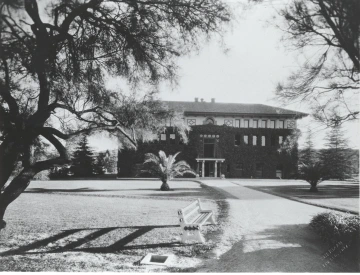
The College of Law's first home: Douglass Building (1904).
Special Collections, University of Arizona Libraries
The law collection rejoined the College of Law in this first “home of its own” in 1929. The old University Library building (1904) was completely remodeled with a “fine modern court room, attractively equipped classrooms, a beautiful and commodious reading and study room, ample stack rooms for the Law Library, and conference and office rooms for the members of the Law Faculty.”[17]
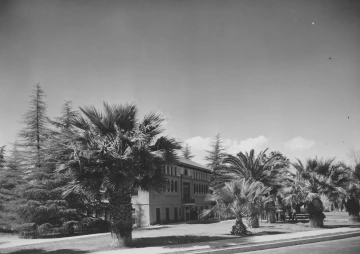
The Douglass Building, built in 1904 as the University Library and reassigned to the College of Law in 1925, was completely remodeled for the College of Law by 1929.
George Geyer, Tucson, Arizona
The law library had over 7,600 volumes in 1929, “including reports of State and Federal Court decisions, digests, encyclopedias, annotated case series, and legal periodicals, with also a representative selection of English and Canadian authorities.”[18] The law library collection continued to grow, reaching more than 10,000 volumes in 1932.[19] The expansions of space and library collections allowed the College of Law to meet the accreditation standards for the American Bar Association (1929) and the Association of American Law Schools (1932).[20]
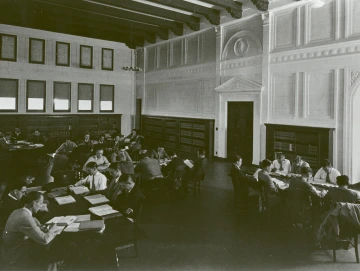
The College of Law’s “beautiful and commodious reading and study room” in the Douglas Building.
Special Collections, University of Arizona Libraries
The College of Law and the law library grew rapidly during the deanship of J. Byron McCormick (1938-1947), just as the State and University of Arizona did throughout the twentieth century, the College of Law added a wing of library stacks in 1948 to support the growing library.[21]
In January 1961, during the deanship of John D. Lyons (1947-1966), the College of Law moved into a new home, the Franklin Building, designed for the College of Law, which included then-sufficient space for its library. “The lower level and mezzanine are devoted exclusively to the 40,000-volume law library, which has a particularly good collection of English reports. Its stacks, numerous study carrels and well-appointed reading tables have rivalled in student popularity even the local taverns and coffee shoppes. Law students enjoy full access to all volumes, and thanks to general observance of the honor system, the library remains reasonably intact from year to year.”[22]
Within five years of moving into the Franklin Building, the College of Law’s enrollment, personnel, and library had reached capacity.[23] Struggling to manage space issues over the next decade, the law library continued to grow.
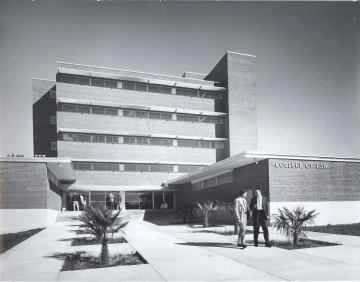
The Franklin Building was the College of Law’s second home from 1961–1979.
Manley Commercial Photography
Under the deanship of Charles Ares ’52 (1966–1973), the College of Law ushered in an era in which the law library collection and staff were increasingly important. In 1965, the University made a special appropriation of $120,000 for the law library.[24] Prior to the appropriation, the law library collection had grown, relatively slowly, to about 44,000 volumes.
Additionally, the law library was administered by a single law librarian, Professor Thomas Tormey, who hired student workers to meet staffing needs.[25] Using the appropriation, the College of Law permitted Professor Tormey to hire Assistant Librarian Jean Humphrey. The collections budget for the law library nearly tripled that year as well, from $27,000 in 1965–66 to $78,000 in 1966–67.[26]
Dean Ares commissioned an outside study of the law library in 1967 which highlighted the need for more library personnel. It noted that Professor Tormey was shelving books himself due to a lack of sufficient staff. There was also a massive backlog of uncatalogued material. Following this study, the College of Law made plans to increase the law library collection to 200,000 volumes and to catalogue the entire collection according to the Library of Congress classification system.[27]
Within six years, by 1973, the collections budget reached nearly $90,000, and the law library held approximately 108,000 volumes. Professor Tormey oversaw a staff of six librarians and six support staff. At the same time, given its proximity to the international border with Mexico, the College of Law decided to expand its Mexican and Latin American law collections, which it did under the leadership and guidance of Professor Boris Kozolchyk, a Cuban and U.S.-trained legal scholar and founder of the National Law Center (which focuses on U.S.–Latin American legal relations), and Eugenio Revilla, a Cuban lawyer and member of the law library team.[28]
As a result of these early efforts, the law library is home to a robust and unique historical collection of primary and secondary Mexican and Latin American legal resources, which flourished under the subsequent curation of law librarian Francisco Avalos and continues to grow to this day.
In 1975, the law library’s collection budget was $115,000[29] but the law library had run out of room for its books. Seating capacity was insufficient for the growing student body as well. According to students, the law library space was woefully inadequate, which prompted Professor Tormey to implement arcane rules and regulations governing student use of study space and books.[30] The good-natured law students warned that those who broke the new library laws would be in violation of the honor code which could result in “creative sentencing in the form of working in the Library without pay.”[31]
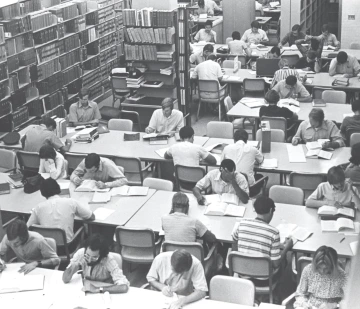
The College of Law outgrew the Franklin Building, including the law library, within five years of opening.
James E. Rogers College of Law
As new books were added to the law library collection, the same number of books were boxed and stored in various locations around the College of Law, including along the back walls of some classrooms[32] and in the women’s restroom.[33] “That the library survived at all as a useful collection is a tribute to Professor Tormey and an overworked staff.”[34]
Finally, in May 1979, under the leadership of Dean Roger Henderson (1977–1983), the College of Law moved into a new and customized building, which remains its current location.[35] The law library had ample space to grow from about 142,000 volumes in 1977 to over 212,000 volumes in 1983.[36] Shortly after moving into its new location, Professor Tormey retired after nearly two decades as the Director of the Law Library.[37] Professor Tormey’s successor, Ronald Cherry (1980-1996), was the first professionally trained librarian to lead the College of Law Library.[38]
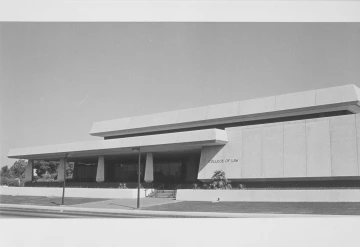
The College of Law moved into its third and current building in 1979. This building, designed for the College of Law, was remodeled in 2008.
Special Collections, University of Arizona Libraries
In the mid-1980s, under the deanship of Paul Marcus (1983-1988) and law library leadership of Ronald Cherry, the College of Law library “was selected by the International Academy of Commercial Law to be one of two worldwide centers (along with the University of Geneva) for the maintenance and distribution of commercial law materials.”[39] At the same time, the University developed a formal partnership with Universidad Nacional Autónoma de México (UNAM) to exchange students and faculty between the two schools, including the law programs.[40] This revived international focus placed a renewed emphasis on collecting foreign, comparative, and international legal materials.
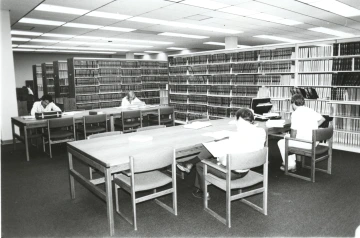
The original law library in the newly created College of Law building c.1979.
James E. Rogers College of Law
The Modern Era
In 1999, the College of Law became known as the James E. Rogers College of Law when James E. Rogers ’62, then-chairman of Sunbelt Communications Company, made a major gift to support the College and to advance all aspects of its mission.[41] In 2005, the law library became the Daniel F. Cracchiolo Law Library in honor of Daniel F. Cracchiolo ’52, co-founder of Burch & Cracchiolo law firm in 1970.
It was at this time that the College of Law underwent its most significant remodeling project since it relocated to its current site. Dean Toni Massaro (1999–2009) oversaw the building project that revitalized the College of Law and turned the law library into the stunning and vibrant center it is today. Michael Chiorazzi, Associate Dean for Information Services and director of the law library (1996–2018), managed the day-to-day operations of the renovation.
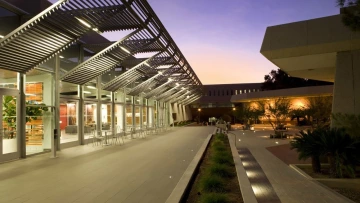
The College of Law courtyard after the 2008 renovation.
James E. Rogers College of Law
The heart of the project was the law library, which was reconceptualized as an information commons blending traditional print resources with cutting-edge information technology and a variety of learning spaces. These spaces are still continually updated and redesigned to accommodate the latest technologies and tools to support the evolving needs of law faculty and students.
Also central to the project was positioning student activities and programs at the forefront of the building’s design and function, reflecting Arizona Law’s identity as a student-centered and collegial center for professional training and engagement. The James E. Rogers College of Law was designed to welcome, teach, and celebrate students. Donors to the project provided aspirational statements about law and lawyers that were added to signage; and the lobbies still display profiles of outstanding alumni who embody the best of law as a public profession.[42]
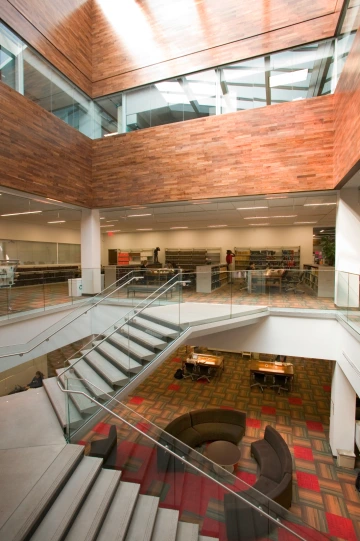
The Law Library was completely remodeled in 2008, allowing more natural light to flow throughout the facility and creating more collaboration, study, and stack space.
James E. Rogers College of Law
The James E. Rogers College of Law is an intimate law school with an entering Juris Doctor (JD) class of approximately 140 students. In addition to its traditional three-year JD program, the College of Law has small Master of Laws (LLM) and Doctor of Science of Law (JSD) programs; and, under the innovative leadership of Dean Marc Miller, created a burgeoning Master of Legal Studies program and the country’s first Bachelor in Law program. The MLS and BA in Law are offered in person and online. The BA in Law is also offered on the University of Arizona’s microcampuses in Asia and Latin America.
The James E. Rogers College of Law had nearly 60 full-time faculty members in Fall 2021 for a JD-student-to-full-time faculty ratio of approximately 4.5-to-1.[43] The College of Law also has over 100 adjunct faculty.[44] Together, the faculty deliver wide-ranging courses. The College of Law is known for its expertise in Indigenous peoples’ law, health law, international business and trade law, tax law, environmental law, constitutional law, criminal law and juvenile justice, immigration law, mining law, tech law, quant law, regulatory science, intellectual property, innovation for justice, legal writing and research, and its extensive clinical offerings.[45]
Worth highlighting is the world-renowned Indigenous Peoples Law & Policy Program (IPLP) at the James E. Rogers College of Law. Arizona Law has been a leader in the field of American Indian and Indigenous peoples’ law, policy, and human rights for nearly three decades, and the IPLP celebrated its 20th anniversary in 2021. The IPLP provides a unique approach to legal education in the fields of federal Indian law, tribal law and policy, and Indigenous peoples human rights. The James E. Rogers College of Law is the only law school in the world offering a concentration in Indigenous peoples’ law and policy for all three graduate degrees in the field (J.D., LL.M, and SJD), a Master of Legal Studies (MLS), and a Master of Professional Studies (MPS). Students are trained in classrooms and clinics by faculty who are leaders in their academic fields as well as practitioners in tribal, national, and international forums.[46]
Further, the Indigenous Governance Program (IGP) is a partnership between the IPLP and the University of Arizona’s Native Nations Institute (NNI).[47] Through IGP, students and scholars connect and collaborate on Native Nation building, Indigenous governance, and economic and community development in Indian country. NNI is one of the premier research institutions in the world with an emphasis on Native nation building. Students can earn a Graduate Certificate in Indigenous Governance, a Continuing Education Certificate, a Master of Professional Studies (MPS) in Indigenous Governance, and a dual JD/MPS degree.[48]
The Modern Law Library
The Daniel F. Cracchiolo Law Library supports the teaching, research, and outreach mission of the College of Law. The law librarians include expert researchers in United States, foreign, comparative, and international law; administrative law including environmental and immigration law; legislative history and analysis; tribal and federal Indian law; intellectual property; archives and special collections. The law library also has expertise in data science, empirical methods, geospatial analysis, and technology. The wide-ranging expertise of the librarians naturally complements and is driven by the research and scholarly expertise of the faculty, as well as the varied technological needs of a 21st century law library.
When fully staffed, the law library is buzzing with nine librarians, a circulation manager, four library assistants, and four Law Library Fellows, who are Graduate Assistants working half-time while studying for their Master’s in Library Science in the University of Arizona’s School of Information. [49]
The unique and acclaimed Law Library Fellows program was created by Associate Dean Chiorazzi in 2000. The Fellows program is now a two-year, residential program that provides opportunities for the Fellows to teach in the legal research curriculum and develop superb legal research skills under the mentorship of seasoned law librarians and the program director. Fellows also work one-on-one with students and public patrons seeking research and reference assistance. The Fellows’ library science education includes specialized courses developed and taught by the law librarians in addition to general library science courses taught by faculty in the University of Arizona School of Information. As Graduate Assistants, the Fellows receive tuition remission for their library science education.[50]
The law librarians are professionally active in local, national, and international library organizations. They research, write, and pursue scholarly interests. They create and teach a variety of courses in the College of Law J.D. and graduate programs, in the B.A. in Law program, and in the School of Information’s library science program. They serve on College of Law and University committees. They collaborate frequently with other librarians on campus, including on search committees. Law librarians are wholly integrated into the academic and intellectual life of the College of Law and the University.
The law library continues to operate autonomously from the University of Arizona Libraries (UAL) system. The Director of the law library reports to the Dean of the College of Law. The College of Law Dean, through the College’s finance office, allocates financial resources directly to the law library. The Director of the law library works with the Dean and the Assistant Dean for Finance and Administration on budgetary matters.
At the same time, the law library collaborates with UAL in sharing its integrated library system (ILS) and catalog. In accordance with a Memorandum of Understanding (Appendix A), the law library contributes to the ILS annual costs based on the percentage of law library catalog records plus maintenance. The law library and UAL also collaboratively purchase or cost-share some electronic resources, and nearly all electronic purchases are made to include campus-wide access unless such broad access is cost-prohibitive or illogical. The Dean of UAL and the Director of the law library meet frequently to discuss library business.
The law library’s mission, priorities, and work are influenced and motivated by the innovative nature of the College of Law, together with the land-grant mission and the HSI- and AIAN-serving designations of the University of Arizona. One result is a broad, deep, and diverse law library collection that supports the teaching, research, and scholarship of the College of Law community. The law library has an expansive foreign and international collection with an emphasis on Mexican and Latin American, global Indigenous peoples, and private and public international law. The law library has an expansive U.S. tribal law collection. The law library also has a rich archive and special collection documenting Arizona’s legal tradition and the University’s history of legal education.
The law library is open to the public and serves the local bench and bar. Thus, the law library makes a concerted effort to maintain robust print collections of Arizona (state) and United States (federal) legal resources. The law library provides public-access computers for access to online legal research databases. Librarians and Law Library Fellows are available to guide members of the public in their legal research.
The law librarians also engage in significant outreach and collaboration with various communities locally and globally. For example, the law library led a collaborative effort with the Athletic Department to create a course for student athletes on name, image, and likeness (NIL). The law library collaborates with the School of Information to educate and train the next generation of law librarians through courses, internships, and fellowships. The law library recently completed a three-year collaboration with the International Dark-Sky Association, based in Tucson, to develop an open-access database of cases, laws, regulations, and literature pertaining to light pollution in the U.S. and abroad. The law library is collaborating with the Navajo Nation, the Haury Program, and LLMC to protect, digitize, and preserve the unique and invaluable Navajo Nation Department of Water Resources Library. Law librarians are also engaged in access-to-justice and library education projects regionally and nationally.
The Daniel F. Cracchiolo Law Library is highly integrated into the intellectual life of the College of Law. The law librarians partner with faculty in their research and instructional missions while ensuring the community of scholars, lawyers, and public patrons have access to a superb collection of legal resources and a comfortable space within which to work. The law library's success is made possible by the support it receives from the College of Law administration. Its ample personnel, administrative, and collections budget allows the law library to be a vibrant center of learning, innovation, and collaboration for the College of Law, the University, and the community.
-- Teresa M. Miguel-Stearns, J.D., MLIS ('06)*
* I am grateful for the superb research and editorial assistance of Daniel G. Bowman ’22. Mr. Bowman uncovered new documents, sources, and details about the history of the College of Law, the Law Library, and legal education in Arizona, through his research at University of Arizona Special Collections (with the assistance of Erika Castaño, Digital Initiatives Archivist & University of Arizona History Curator) and the Daniel F. Cracchiolo Law Library Special Collections (with the assistance of Jaime Valenzuela, Archivist). This chapter would not be as well-resourced and documented without Mr. Bowman’s diligence and dedication. I am grateful for the assistance of my colleagues at the College of Law for their suggestions as well, including Dean Marc Miller, Dean Emerita Toni Massaro, and Karen Kowalski. A version of this essay appears in Organizational Structures for Academic Law Libraries: Past, Present, and Future, (eds. Beth Adelman and Jessica de Perio Wittman) (William Hein & Co. 2023).
[1] About Arizona, Univ. Ariz., https://www.arizona.edu/about (last visited Oct. 26, 2021).
[2] Margaret Mitchell, The Founding of the University of Arizona 1885–1894, 27 J. Sw. 5, 5 (1985).
[3] The Univ. of Ariz., The University of Arizona: Historical and Pictorial 11 (1930) https://hdl.handle.net/2027/uiug.30112111514367. The University was most recently recognized as a member in 1985. AAU Member Universities, Ass’n Am. Univs., https://www.aau.edu/sites/default/files/AAU-Files/Who-We-Are/AAU-Member-List.pdf (last visited July 3, 2021).
[4] Institutional Capacity, Univ. Ariz., https://research.arizona.edu/development/institutional-capacity (last visited July 3, 2021).
[5] See The Univ. of Ariz., Minutes of Meetings of the University of Arizona Faculty Vol. 1 412 (Sept. 27, 1909) (on file with University of Arizona Special Collections).
[6] John D. Lyons, The First Fifty Years of the College of Law, 7 Ariz. L. Rev. 173 (1966). Lyons was Dean of the College of Law from 1947 until 1964.
[7] Id.
[8] The Univ. of Ariz., supra note 3, at 15. See also, University of Arizona, 1919-1920 Annual Catalogue, at 148, for the first instance of School of Law rather than Department of Law, as named in the 1918-1919 Annual Catalogue, at 135.
[9] Lyons, supra note 6, at 175; see also 1925 Ariz. Sess. Laws 248 (last codification at A.R.S. § 15-702 (1976)) (repealed 1982). Samuel M. Fegtly was Dean of the College of Law from 1925-1938.
[10] Douglas D. Martin, The Lamp in the Desert 112 (2014); Twenty-Eighth Annual Catalogue 1918–1919, Univ. Ariz., Apr. 1919, at 199, https://repository.arizona.edu/handle/10150/580385.
[11] Started Ten Years Ago as Department, Ariz. Wildcat, May 22, 1925, at 3 (“Law Edition”); Thirty-First Annual Catalogue 1921–1922, Univ. Ariz., Apr. 1922, at 200, https://repository.arizona.edu/handle/10150/580382.
[12] Act of Mar. 7, 1919, ch. 43, 1919 Ariz. Sess. Laws 50.
[13] Act of Mar. 12, 1925, ch. 56, 1925 Ariz. Sess. Laws 163; see also, In re Miller, 29 Ariz. 582, 588–89 (1926).
[14]Twenty-Fifth Annual Catalogue 1915–1916, Univ. Ariz., May 1916, at 28, https://repository.arizona.edu/handle/10150/580383. Harry Westover ('19) worked as a library shelf asssistant during his time as a student. Id. at 18.
[15] Twenty-Ninth Annual Catalogue 1919–1920, Univ. Ariz., Apr. 1920, at 30, https://repository.arizona.edu/handle/10150/580410.
[16] Estelle Lutrell, History of the University of Arizona from 1885–1926 299 (1947) (unpublished manuscript) (on file with University of Arizona Special Collections); Annual Report 1925–1926, Univ. Ariz. Library (1926), https://repository.arizona.edu/handle/10150/202489.
[17] The Univ. of Ariz., supra note 3, at 15.
[18] Id. at 6.
[19] Lyons, supra note 6, at 176.
[20] Id. According to Lyons, ABA accreditation required a library of at least 7,500 volumes. The College of Law received accreditation from the ABA during the ABA Annual Meeting in 1930, retroactive to September 1, 1929. The Association of American Law Schools required a law library collection of 10,000 volumes.
[21] Id. at 175.
[22] Robert E. Riggs, Arizona . . . A New Look on the Old Frontier, 8 Student L. J. 18, 19 (1963).
[23] Lyons, supra note 6, at 181.
[25] Id. at 17–18.
[26] Id.
[27] Id. at 18.
[28] Id.
[29] Ann Littrell, Library Receives Additional Funding, Ariz. Advocate 1 (Dec. 1975). The Arizona Advocate was a student-published College of Law newsletter.
[30] See New Library Rules, Ariz. Advocate 4 (Dec. 1975).
[31] Id.
[32] Nichols, supra note 24, at 18.
[33] Id. at 28.
[34] Id. at 18.
[35] Id. at 33.
[36] Id. at 34.
[37] Id.
[38] Professor Ron Cherry Retires, Univ. Ariz. L. Rec., Spring 1996, at 13, https://repository.arizona.edu/handle/10150/612117. The Arizona Law Record was a College of Law publication.
[39] Nichols, supra note 24, at 45.
[40] Id.
[41] At the time, this pledge of $115 million was the largest ever awarded to an American law school. See UA Alumnus and Longtime Benefactor James E. Rogers Dies, Univ. Ariz. (June 16, 2014), https://news.arizona.edu/story/ua-alumnus-and-longtime-benefactor-james-e-rogers-dies.
[42] Email from Toni Massaro, Dean Emerita Univ. of Ariz. James E. Rogers Coll. of L., to Teresa Miguel-Stearns (Oct. 31, 2021) (on file with author).
[43] Conversation between Karen Kowalski, Assoc. Dean for Admin. and Chief of Staff, and Teresa Miguel-Stearns (Nov. 1, 2021).
[44] Am. Bar Assn., 2020 ABA Standard 509 Information Report (Oct. 12, 2021), https://law.arizona.edu/consumer-information-aba-required-disclosures.
[45] James E. Rogers College of Law: Programs and Areas of Study, Univ. Ariz., https://law.arizona.edu/programs (last visited Oct. 31, 2021).
[46] Indigenous Peoples Law and Policy, Univ. Ariz. https://law.arizona.edu/programs/indigenous-peoples-law-policy (last visited Nov. 1, 2021)
[47] Indigenous Governance Program, Univ. Ariz., https://law.arizona.edu/programs/indigenous-governance-program (last visited Nov. 1, 2021).
[48] Id.
[49] Daniel F. Cracchiolo Law Library: Staff Directory, Univ. Ariz.http://lawlibrary.arizona.edu/about/staff-directory (last visited Oct. 31, 2021).
[50] Daniel F. Cracchiolo Law Library: Fellows Program, Univ. Ariz. http://lawlibrary.arizona.edu/about/fellows-program (last visited, Nov. 4, 2021).
[51] Ariz. Bd. of Regents, University Handbook for Appointed Personnel, Chapter 4: Personnel Policies and Procedures for Academic and Service Professional Employees, Univ. Ariz. (Jan. 13, 2020), https://policy.arizona.edu/university-handbook-appointed-personnel.
[52] Ariz. Bd. of Regents, University Handbook for Appointed Personnel, Chapter 5: Personnel Policies and Procedures for Administrative Personnel, Univ. Ariz. (Aug. 23, 2016), https://policy.arizona.edu/university-handbook-appointed-personnel.

